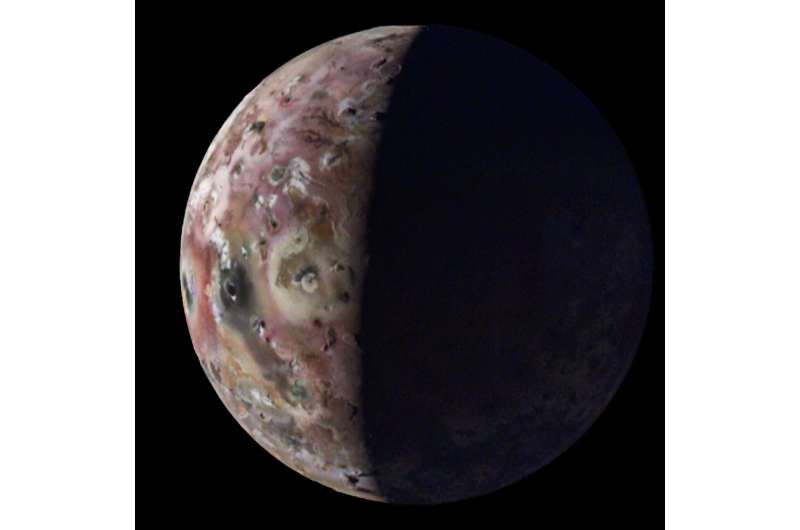This article has been reviewed according to Science X's editorial process and policies. Editors have highlighted the following attributes while ensuring the content's credibility:
fact-checked
trusted source
proofread
NASA's Juno gives aerial views of mountain and lava lake on Io

Scientists on NASA's Juno mission to Jupiter have transformed data collected during two recent flybys of Io into animations that highlight two of the Jovian moon's most dramatic features: a mountain and an almost glass-smooth lake of cooling lava. Other recent science results from the solar-powered spacecraft include updates on Jupiter's polar cyclones and water abundance.
The new findings were announced Wednesday, April 16, by Juno's principal investigator Scott Bolton during a news conference at the European Geophysical Union General Assembly in Vienna.
Juno made extremely close flybys of Io in December 2023 and February 2024, getting within about 930 miles (1,500 kilometers) of the surface, obtaining the first close-up images of the moon's northern latitudes.
"Io is simply littered with volcanoes, and we caught a few of them in action," said Bolton. "We also got some great close-ups and other data on a 200-kilometer-long (127-mile-long) lava lake called Loki Patera. There is amazing detail showing these crazy islands embedded in the middle of a potentially magma lake rimmed with hot lava. The specular reflection our instruments recorded of the lake suggests parts of Io's surface are as smooth as glass, reminiscent of volcanically created obsidian glass on Earth."
Maps generated with data collected by Juno's Microwave Radiometer (MWR) instrument reveal Io not only has a surface that is relatively smooth compared to Jupiter's other Galilean moons, but also has poles that are colder than middle latitudes.
Pole position
During Juno's extended mission, the spacecraft flies closer to the north pole of Jupiter with each pass. This changing orientation allows the MWR instrument to improve its resolution of Jupiter's northern polar cyclones. The data allows multiwavelength comparisons of the poles, revealing that not all polar cyclones are created equal.
"Perhaps most striking example of this disparity can be found with the central cyclone at Jupiter's north pole," said Steve Levin, Juno's project scientist at NASA's Jet Propulsion Laboratory in Southern California.
"It is clearly visible in both infrared and visible light images, but its microwave signature is nowhere near as strong as other nearby storms. This tells us that its subsurface structure must be very different from these other cyclones. The MWR team continues to collect more and better microwave data with every orbit, so we anticipate developing a more detailed 3D map of these intriguing polar storms."
Jovian water
One of the mission's primary science goals is to collect data that could help scientists better understand Jupiter's water abundance. To do this, the Juno science team isn't hunting for liquid water. Instead, they are looking to quantify the presence of oxygen and hydrogen molecules (the molecules that make up water) in Jupiter's atmosphere. An accurate estimate is critical to piecing together the puzzle of our solar system's formation.
Jupiter was likely the first planet to form, and it contains most of the gas and dust that wasn't incorporated into the sun. Water abundance also has important implications for the gas giant's meteorology (including how wind currents flow on Jupiter) and internal structure.
In 1995, NASA's Galileo probe provided an early dataset on Jupiter's water abundance during the spacecraft's 57-minute descent into the Jovian atmosphere. But the data created more questions than answers, indicating the gas giant's atmosphere was unexpectedly hot and—contrary to what computer models had indicated—bereft of water.
"The probe did amazing science, but its data was so far afield from our models of Jupiter's water abundance that we considered whether the location it sampled could be an outlier. But before Juno, we couldn't confirm," said Bolton. "Now, with recent results made with MWR data, we have nailed down that the water abundance near Jupiter's equator is roughly three to four times the solar abundance when compared to hydrogen. This definitively demonstrates that the Galileo probe's entry site was an anomalously dry, desert-like region."
The results support the belief that the during formation of our solar system, water-ice material may have been the source of the heavy element enrichment (chemical elements heavier than hydrogen and helium that were accreted by Jupiter) during the gas giant's formation and/or evolution. The formation of Jupiter remains puzzling, because Juno results on the core of the gas giant suggest a very low water abundance—a mystery that scientists are still trying to sort out.
Data during the remainder of Juno's extended mission may help, both by enabling scientists to compare Jupiter's water abundance near the polar regions to the equatorial region and by shedding additional light on the structure of the planet's dilute core.
During Juno's most recent flyby of Io, on April 9, the spacecraft came within about 10,250 miles (16,500 kilometers) of the moon's surface. It will execute its 61st flyby of Jupiter on May 12.
Provided by NASA



















